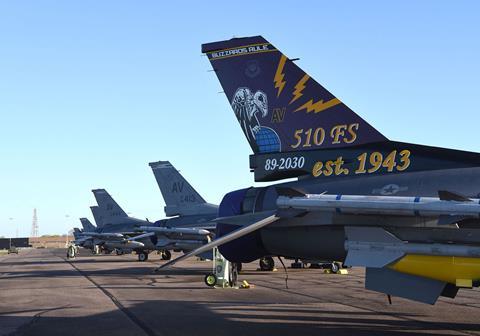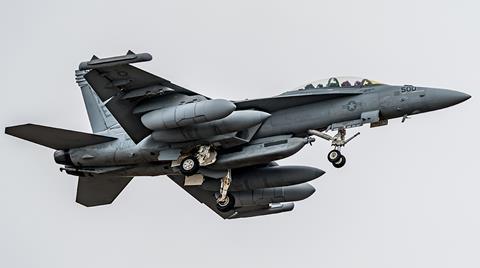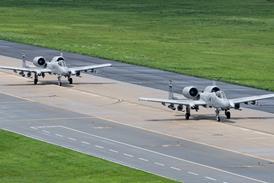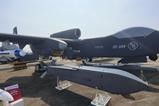Could the US Air Force (USAF) soon restore its defunct electronic attack fighter capability?
In light of active conflicts around the globe, and signals coming from service leaders, at least one major defence manufacturer sees opportunity in the prospect.
The USAF has not operated a dedicated electronic attack fighter since 1998, when the service retired its General Dynamics EF-111A Raven jets – derived from the F-111 Aardvark swept-wing fighter bomber.
Since then, the service has left stand-in jamming missions to the US Navy (USN), and now operates a variant of the single-seat Lockheed Martin F-16 strike fighter – designated the F-16CM – outfitted with specialised targeting pods and munitions for attacking enemy air defences.
During remarks at the 2024 Air & Space Forces Association (AFA) conference in Washington, DC earlier this month, air force secretary Frank Kendall described electronic warfare (EW) as a “historically neglected area” and a “key enabler” to the service’s operational imperative of ensuring air superiority against near-peer adversaries.
“We believe we can counter advanced adversary kill webs by integrating a combination of electronic warfare tools,” Kendall says.
He cites observations collected from the ongoing Russia-Ukraine war as supporting this conclusion.

The USAF does have an existing electronic attack capability in the form of Compass Call aircraft – first housed in the EC-130H turboprop and more recently in the EA-37B militarised business jet. Both aircraft carry advanced sensor packages from BAE Systems capable of jamming and disrupting air defence radars. L3Harris is the systems integrator for both platforms.
While the Gulfstream G550-based EA-37B offers improved speed and stand-off capability than the modified Lockheed C-130 transport variant, neither platform is suited for the type of close-in suppression of enemy air defences (SEAD) for which high-speed, fighter-based jamming and detection platforms were traditionally used. Such platforms have included the EF-111 and, earlier, the McDonnell Douglas F-4 Phantom II and Republic F-105 Thunderchief.
When the USAF retired its Raven fleet, their role in the SEAD mission was taken over by a missile – Raytheon’s radar-seeking AGM-88 High-Speed Anti-Radiation Missile (HARM), which was paired with the F-16CM. Globally, the air force maintains just a handful of F-16 squadrons outfitted for the so-called “Wild Weasel” SEAD mission.
By contrast, the USN has opted to maintain a dedicated electronic attack fighter in its inventory, first in the form of the Northrop Grumman EA-6B Prowler and now with the Boeing EA-18G Growler.
While there seems to be little prospect of the USAF developing a new electronic attack fighter, defence manufacturer Raytheon sees opportunity in expanding the capability of existing USAF fighter platforms to include offensive electronic attack.
“The navy has been the leader,” says Chuck Angus, business director for airborne electronic attack at Raytheon. “Clearly, they’ve been the leader in offensive electronic attack.”

The USN maintains 153 carrier-capable EA-18Gs that can be deployed anywhere in the world, alongside 12 examples operated by the Royal Australian Air Force.
Raytheon provides the Next Generation Jammer (NGJ) Mid-Band electronic attack pod, two of which are standard loadout for the Growler. The system provides critical EW capabilities, including degrading and disrupting enemy communications and air defences.
Despite his company’s role in the EA-18G programme, Angus says the global defence market has generally shown little interest in bespoke electronic warfare jets.
“It’s not about the dedicated EW platform anymore,” he notes. “There’s nobody else flying the Growler.”
Raytheon is now pursuing the strategy of adapting the NGJ to other fighters currently in the inventory. Angus describes this as adding more electronic-attack capacity to the existing capabilities provided by the specialised Growler fleet.
Building out such capacity will help allied air forces better accomplish their conventional air dominance and SEAD objectives, Angus argues. “If you want to get in close to drop your ordnance, you need to reduce the detection range of your adversary.”
The USAF has opted to solve the detection problem by adding low-observable stealth technology to both strike fighters and bombers. By contrast, the navy has chosen to base the bulk of its tactical air fleet on the non-stealthy F/A-18E/F Super Hornet, with a smaller number of EA-18Gs providing electronic-attack support to counter air-defence vulnerabilities.

Angus says international operators have generally chosen to follow the USAF’s approach. Finland and Germany were offered the Super Hornet and Growler combination for their respective fighter replacement programmes, and both countries opted for the stealthy Lockheed F-35 strike fighter instead.
Despite clear preference for stealth, Raytheon sees opportunity in providing electronic-attack capability in a modular form like the NGJ pod.
“There’s some realisation that they’re not going to get that whole electronic-attack capability without the Growlers,” Angus says.
One major selling point of such a capability is how it can address another major concern in Western capitals: a shortage of precision munitions, stocks of which are predicted to be quickly exhausted in the event of a high-end military conflict.
“A lot of US and international partners are concerned about how many weapons they have,” Angus notes. “Electronic attack gives you the ability to support that weapon all the way to the target and it helps deny the adversary from detecting it and mitigating it before it gets to the target.”
While stealth technology can protect targeting aircraft, it does not protect air-to-surface missiles after launch. That means hitting a single SEAD objective might require firing several weapons to ensure destruction.
An onboard airborne electronic attack capability could mitigate that.
“Instead of dropping five bombs, maybe you only have to drop three to get the effect that you’re after,” Angus says. “The non-kinetic effect is making the kinetic more effective.”
Adapting the Growler’s electronic attack pod for other aircraft could offer one route to achieving that. At 544kg (1,200lb), Raytheon’s NGJ is “appropriate for a large swath of platforms”, Angus says. This could include not just fighters, but USAF heavy bombers.

While the USN pulled the plug on adapting the system for its F-35Cs more than a decade ago, the ability of the NGJ to generate its own electrical power could make it an attractive option for the single-engined fighter, whose onboard power supply is notoriously overtaxed by advanced sensors.
With 20 countries now operating or committed to fielding F-35s, the stealth fighter provides an appealing business opportunity.
Smaller craft, such as the autonomous Collaborative Combat Aircraft (CCA) under development for the USAF are another possible host for an electronic-attack capability, though the existing NGJ package would likely need to be adapted to the reduced payloads of those aircraft.
For comparison, the AIM-120 Advanced Medium Range Air-to-Air Missile Raytheon is integrating into the first generation of CCAs weighs around 150kg, according to the air force.
With plans in the works to field hundreds of such vehicles in the near future, an electronic-attack offering presents another strong business opportunity for Raytheon.
Separately, the US Marine Corps is reportedly considering an uncrewed electronic-attack jet based on Kratos’s XQ-58A Valkyrie. That service recently completed its third test flight of an XQ-58, with follow-on exercises planned.
Kratos in April said the test programme is informing requirements for an uncrewed tactical aircraft to be used in a SEAD role, which the company names the MQ-58B.
With an already active NGJ production line in Forest, Mississippi, Angus says Raytheon is well positioned to supply any future electronic-attack customers.































